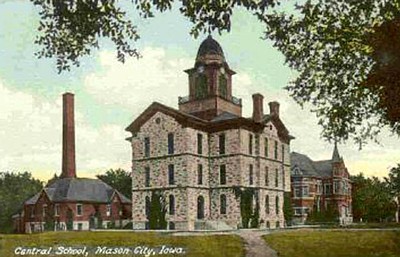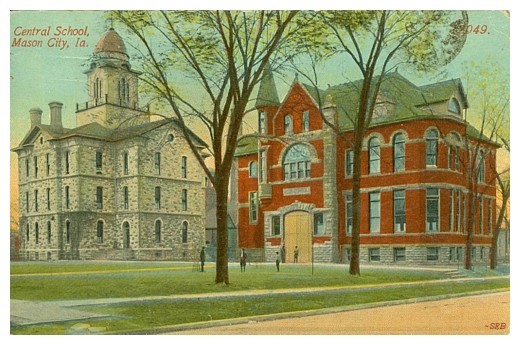


Cerro Gordo County Iowa
Part of the IaGenWeb Project
|
Dedicated 1874

Globe-Gazette, Mason City, Cerro Gordo County, Iowa The big event in Mason City in 1874 was the dedication of the new stone central school, which stood on the present [1953] site of the school administration building. It was a bold step that the school board took in 1872 to erect this three-story building that for years was to tower over the countryside, a building large enough to house both grade and high school. It was a daring project for so small a community. It was truly the venture, or at least most ingenious, was the method adopted to pay the $30,000 cost of the building by enlarging the Mason City independent school district by 60 square miles, thus giving many more property owners of the county an opportunity to help pay for and maintain the school. The board proved as adept at gerrymandering as experienced politicians. The district became a zigzag corridor leading to a large area in the southwest corner of the county, where the land was owned by eastern investors. Soon after this a new township was created and the Mason City district became the area in and immediately surrounding the city. But by that time much of the building cost had been raised, a larger population supported the school and the first class had been graduated from the high school.
This old central school, built of stone from local quarries, was to stand for more than a half century as a landmark. it was erected in the center of block 26, which in the original plat of Mason City had been set aside by [Mason City founding fathers John B.] Long and [George] Brentner for a county courthouse. With Block 26 and other properties tied up in receivership and litigation, the county built the courthouse on the rim of Central Park. As an aftermath of the 1857 panic judgments were entered by eastern creditors against most of Mason City's real estate, which was sold at sheriff's sale. Title to much of the property had to [be] quieted by a deluge of quit claim deeds. Such was the situation with Block 26. The school district acquired title on March 12, 1872, by a quit claim deed given by Thomas G. and Nancy M. Hartshorn for $850. Later in the year the county supervisors voted a quit claim deed, thus abrogating any claim the county might have. Contracts were let for the erection of the building, which many settlers felt was so large the rooms would never be fully occupied. But the board was confident. Two years before - June, 1870 - a proposition to build a county high school in Lake Township, midway between Mason City and Clear Lake was defeated 463 to 269. This made certain Mason City's dominance in education for the surrounding area. A bond issue of $20,000 was voted and taxes were assessed for the additional $10,000. The cornerstone was laid July 4, 1872. E. C. Moulton, county superintendent, delivered the address. A tin box containing a copy of the school laws, the Mason City Express, court calendar, Moulton's address and three half dollars were placed in the stone. These items were found in a badly decomposed condition after a fire destroyed the building Dec. 14, 1926. Dedication of the building that most citizens felt was too large for the town, took place Oct. 9, 1874, with J. C. Gilchrist, Mason City's first superintendent of schools, giving the address. Completion of the building came after serious delay caused by the fact that the contractor walked off the job.
A serious delay took place in the construction of the school. The contract for the erection of the building was let by public bids and bonds put up and the building contract signed by the builder with County residents for a brick building. The contract was changed and a stone building erected without consent of the bondsmen. This oversight cost the district dearly. The basement and all of the first story walls were put up and the partition walls for the second story, the contractor being paid on estimates as the work progressed. At this point the contractor quit work and left. The building was left standing in this condition for a year or more and then the school board proceeded to procure materials and labor and finally completed the building in the fall of 1874. The board then commenced suit against the contractor and bondsmen for the excess cost of finishing the building over the contract price. The suit was tried in Marion County. The board was given judgment against the contractor from who[m] they were unable to recover the loss, but not against the bondsmen as they had not consented to the change from brick to stone. Besides the cost of the stone construction was shown to be higher than brick.
While the building was under construction school was held in the old stone school and in store buildings downtown. Three stories in height, besides the basement, with a cupola surmounted by a flag staff, the building became an imposing sight. Hung in the cupola was the old bell taken from the first [old stone] two room school. Members of the board at this time were Horace G. Parker, father of C. A. Parker, A. B. Tuttle, Dr. W. W. Allen, George W. Sanborn and D. M. Tiffany. Dedication of the building took place Oct. 9, 1874, with J. C. Gilchrist, Mason City's first superintendent of schools, giving the address. A cornet band and a choir provided music. A. B. Tuttle of the school board presented the building to the people of Mason City. Gilchrist went on from Mason City in 1875 to become the founder and first president of Iowa State Teachers College at Cedar Falls. He was to be the first of a number of Mason City school men and women to rise to prominence in the state and nation. NOTE: Prof.
James Cleland
Gilchrist was born in 1831, Allegheny City, Pennsylvania, grew up on an Ohio farm, and died at his home near Laurens, Iowa on
August 12, 1897 at the ages of 66 years. He came to Iowa in 1871 and was involved with school work in Mason City, Sioux City and Algona. Upon
establishing the Iowa State Normal School at Cedar Falls, he became the institution's principal and held that position
for ten years. An ordained Methodist minister, his main interest and work was conducted in the field of education.
By 1878 the high school, which occupied the third floor of the building, graduated its first class. The seven graduates were: R. W. Montague, Ellen A. Barton, R. J. Miller, Minnie Egloff (Long), Ella Mayne (Lucas), Alpha Valentine and Lucy Barton (Alexander). School enrollment grew so rapidly that by 1890 a red brick building was erected to the east of old Central at a cost of $15,000. It was originally used as a high school and later as a grade school.

On Dec. 4, 1926, the old historic Central school building, erected in 1872, was destroyed by fire. When the cornerstone was uncovered, it was discovered that the heat from the fire had cracked the stone and the tin box, holding the records put into it over a half century before had rusted. The papers put into the box with such pomp and ceremony at the cornerstone laying were so decayed it was impossible to handle them. Stone from the old building was used in constructing the present [1953] administration building in 1928. Transciptions by Sharon R. Becker, February of 2011; updated November & December of 2014
|